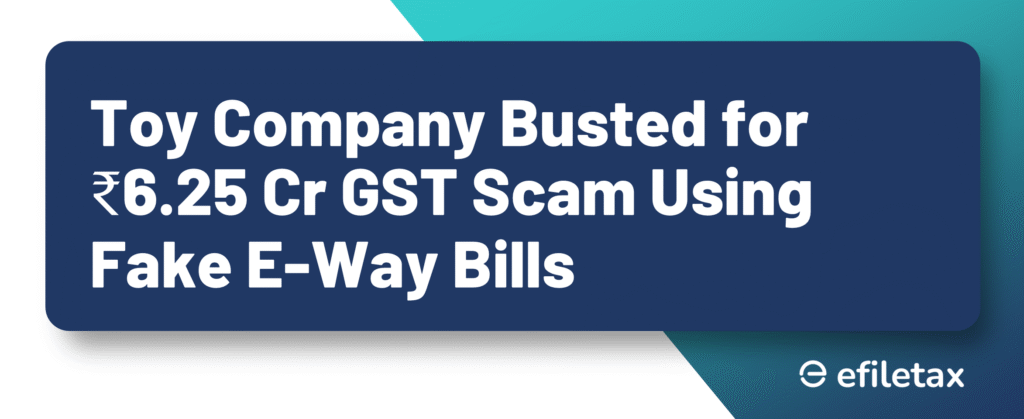
GST fraud in toy trading: ₹6.25 crore scam exposed
A shocking case of GST fraud in toy trading has come to light involving a ₹6.25 crore scam. A Delhi-based firm allegedly used fake addresses and bogus e-waybills to evade taxes. The case highlights how loopholes in documentation and verification can be exploited—and why taxpayers must stay alert.
What exactly happened?
The Directorate General of GST Intelligence (DGGI), Gurugram Zonal Unit, uncovered that the toy trading firm had:
- Used a non-existent address for GST registration
- Generated fake e-waybills to show movement of goods
- Passed on bogus Input Tax Credit (ITC) of over ₹6.25 crore to other firms
- Had no actual business activity at the registered premises
Key legal provisions violated
| Provision | Legal Reference | Implication |
|---|---|---|
| Fraudulent ITC | Sec 132(1)(c) | Punishable with imprisonment & fine |
| Fake invoicing | Sec 122(1)(ii) | Penalty equal to tax evaded |
| Bogus registration | Rule 25 of CGST Rules | Allows physical verification & cancellation |
| E-waybill misuse | Rule 138 | Results in penalty, confiscation |
Why this matters: Compliance risks for all businesses
Even if you’re not running a fake firm, associating with one—intentionally or not—can land you in legal trouble.
Businesses must ensure:
- Suppliers are physically traceable
- GSTIN verification is done via GST portal
- ITC is claimed only if invoices are valid and services are received
Expert view: Due diligence is non-negotiable
According to CA experts, “Firms must now treat every vendor onboarding like a KYC process. Check PAN, Aadhaar linkage, address proof, and return filing status. One fraudulent vendor can ruin your entire ITC trail and bring on departmental scrutiny.”
What can tax authorities do?
The GST department has legal powers under:
- Section 83 – Provisional attachment of bank accounts
- Section 67 – Search, seizure, and inspection
- Section 29 – Suo-motu cancellation of GST registration
- Rule 21A – Suspension of registration for suspected fraud
How to protect your business from similar frauds
Step-by-step preventive checklist:
- Verify GSTINs before onboarding any vendor
- Use automated tools to track return filing status of suppliers
- Avoid cash transactions for goods under GST
- Reconcile GSTR-2B with books before claiming ITC
- Flag suppliers with high ITC pass-through and low turnover
Focus keyphrase subheading: GST fraud in toy trading and its red flags
Red flags to watch out for:
- Suppliers who don’t file GSTR-3B or GSTR-1 regularly
- E-waybills that don’t match invoice dates or routes
- Vendors with unusually high ITC claims and no website/contact
- Addresses linked to multiple unrelated GSTINs
Official reference
The case was reported by the DGGI, an enforcement arm under CBIC. For more on ITC fraud detection and fake firm crackdown, refer CBIC’s official press releases at:
🔗 https://cbic.gov.in
summary
A toy trading firm used a fake address and bogus e-waybills to claim and pass on fraudulent GST Input Tax Credit worth ₹6.25 crore. DGGI busted the scam. Learn how such frauds happen, legal implications, and how to protect your business with due diligence.
FAQs on GST fraud and compliance
Q1: Can a buyer be held liable if a seller is found to be fake?
Yes, if ITC is availed on fake invoices, the buyer may face reversal, interest, and penalties—even if they were unaware.
Q2: How to verify if a GSTIN is genuine?
Visit gst.gov.in > Search Taxpayer > Enter GSTIN or PAN to validate details.
Q3: What is the penalty for fake invoicing?
Equal to the amount of tax evaded, along with possible jail time under Section 132.
Final thoughts: Stay compliant, stay safe
GST fraud in toy trading isn’t just an isolated case—it’s a wake-up call. Whether you’re a manufacturer, trader, or service provider, one weak link can collapse your tax chain.
Don’t risk it. Trust Efiletax for foolproof GST registration, ITC reconciliation, and compliance audits.